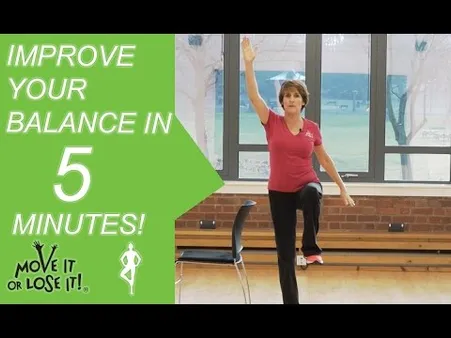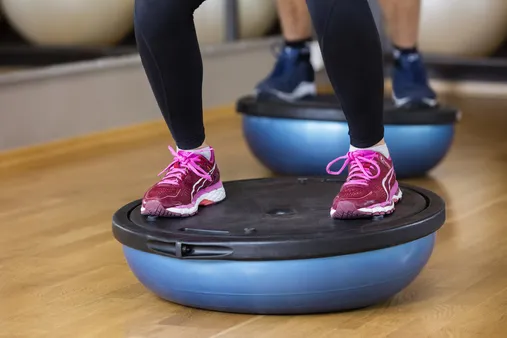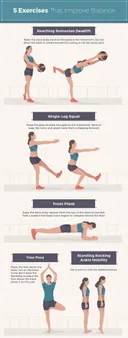Table of Contents
Balance is an essential aspect of our daily lives, allowing us to perform routine activities, from walking and standing to playing sports and maintaining good posture. However, as we age or encounter certain health conditions, our balance can deteriorate, leading to instability, falls, and injuries. This comprehensive guide provides a wealth of practical tips, effective exercises, and advice to help you improve your balance, regain confidence, and enjoy a safer, more fulfilling life. Whether you're experiencing balance issues or simply seeking ways to enhance your overall stability, Kizworld has the answers you need. Let's dive in and explore proven strategies to master your balance and move with confidence.
How to Improve Your Balance and Stability in Daily Life
I. Improve Your Balance and Stability
Improve Your Balance and Stability
Balance and stability are essential for everyday activities, from walking and standing to playing sports. Poor balance can increase your risk of falls, injuries, and even disability. The good news is that you can improve your balance and stability with a few simple exercises and lifestyle changes.
Here are 10 tips to help you improve your balance and stability:
- Strengthen Your Core: Your core muscles play a vital role in balance and stability. To strengthen your core, do exercises that target your abdominal and back muscles, such as planks, crunches, and sit-ups.
- Improve Your Proprioception: Proprioception is your body's ability to sense its position in space. To improve your proprioception, try exercises that challenge your balance, such as standing on one leg or walking on a balance beam.
- Practice Single-Leg Exercises: Single-leg exercises are a great way to improve your balance and stability. Try exercises like single-leg squats, lunges, and deadlifts.
- Use Balance Training Equipment: There are a variety of balance training equipment available, such as balance boards, wobble boards, and stability balls. Using this equipment can help you improve your balance and stability in a fun and challenging way.
- Try Tai Chi or Yoga: Tai Chi and yoga are both excellent ways to improve your balance and stability. These mind-body practices teach you how to focus your attention, relax your body, and move with fluidity.
II. Strengthen Your Core
Your core muscles are located in your abdomen and back. They help to stabilize your spine and pelvis, and they play a key role in balance and stability. To strengthen your core, you can do exercises such as:
- Planks
- Crunches
- Sit-ups
- Bridges
- Superman
Aim to do these exercises for at least 10-15 repetitions, 2-3 times per week. As you get stronger, you can increase the number of repetitions and sets.
III. Improve Your Proprioception
Proprioception is your body's ability to sense its position in space. This sense is important for balance and stability, as it allows you to make adjustments to your posture and movement as needed. To improve your proprioception, you can do exercises such as:
- Standing on one leg
- Walking on a balance beam
- Heel-toe walking
- Side-to-side walking
- Forward and backward walking
Start by doing these exercises for a few minutes each day. As you get better, you can increase the duration and difficulty of the exercises.
IV. Practice Single-Leg Exercises
Single-leg exercises are a great way to improve your balance and stability. These exercises challenge your body to maintain balance on one leg, which helps to strengthen your core and improve your proprioception. Some examples of single-leg exercises include:
- Single-leg squats
- Single-leg lunges
- Single-leg deadlifts
- Single-leg bridge
- Single-leg hop
Start by doing these exercises for a few repetitions on each leg. As you get stronger, you can increase the number of repetitions and sets.
V. Use Balance Training Equipment
There are a variety of balance training equipment available that can help you improve your balance and stability. Some examples include:
- Balance boards
- Wobble boards
- Stability balls
- Bosu balls
- Gym balls
Using this equipment can help you challenge your balance in a safe and controlled environment. Start by using the equipment for a few minutes each day. As you get more comfortable, you can increase the duration and difficulty of your workouts.
VI. Try Tai Chi or Yoga
Tai Chi and yoga are both excellent ways to improve your balance and stability. These mind-body practices teach you how to focus your attention, relax your body, and move with fluidity. Tai Chi and yoga can also help to reduce stress, which can also improve your balance.
If you're new to Tai Chi or yoga, there are many classes and resources available to help you get started. You can also find many Tai Chi and yoga videos online.
VII. Get Regular Exercise
Getting regular exercise is one of the best ways to improve your overall health and well-being, including your balance and stability. Aim for at least 30 minutes of moderate-intensity exercise most days of the week. This could include activities such as walking, swimming, biking, or dancing.
If you're new to exercise, start slowly and gradually increase the duration and intensity of your workouts over time. Be sure to listen to your body and stop if you feel pain.
VIII. Eat a Healthy Diet
Eating a healthy diet is important for overall health and well-being, including balance and stability. Make sure to eat plenty of fruits, vegetables, and whole grains. These foods are packed with nutrients that are essential for good health.
Limit your intake of processed foods, sugary drinks, and unhealthy fats. These foods can contribute to weight gain and other health problems, which can make it more difficult to maintain balance and stability.
IX. Get Enough Sleep
Getting enough sleep is essential for overall health and well-being, including balance and stability. When you don't get enough sleep, you're more likely to feel tired and fatigued, which can make it more difficult to maintain balance and stability.
Aim for 7-8 hours of sleep each night. If you have trouble sleeping, there are a number of things you can do to improve your sleep, such as:
- Going to bed and waking up at the same time each day, even on weekends
- Creating a relaxing bedtime routine
- Making sure your bedroom is dark, quiet, and cool
- Avoiding caffeine and alcohol before bed
X. Manage Stress
Stress can take a toll on your physical and mental health, including your balance and stability. When you're stressed, your body releases hormones that can make it more difficult to maintain balance and stability.
There are a number of things you can do to manage stress, such as:
- Exercise
- Yoga
- Tai Chi
- Meditation
- Spending time in nature
- Talking to a friend or therapist
By following these tips, you can improve your balance and stability and reduce your risk of falls and injuries.
XI. Balance Exercises for Different Situations
Balance Exercises for Different Situations
Standing on One Leg
- Stand with your feet shoulder-width apart.
- Lift your right leg off the ground and bend your knee at a 90-degree angle.
- Hold this position for 30 seconds.
- Repeat with your left leg.
This exercise helps to improve your balance and coordination. It also strengthens your core muscles.
Heel-Toe Walk
- Start with your feet together.
- Take a step forward with your right foot and place your heel in front of your left foot.
- Then, take a step forward with your left foot and place your heel in front of your right foot.
- Continue walking in this manner for 20 steps.
This exercise helps to improve your balance and coordination. It also strengthens your calf muscles.
Single-Leg Bridge
- Lie on your back with your knees bent and your feet flat on the floor.
- Lift your right leg off the ground and extend it straight out.
- Keeping your left foot flat on the floor, raise your hips until your body forms a straight line from your shoulders to your knees.
- Hold this position for 30 seconds.
- Lower your hips and repeat with your left leg.
This exercise helps to improve your balance and core strength. It also strengthens your hamstrings and glutes.
Balance Board Exercises
- Stand on a balance board with your feet shoulder-width apart.
- Shift your weight from side to side and front to back.
- Try to keep your balance for as long as possible.
- You can also try doing exercises on the balance board, such as squats, lunges, and push-ups.
Balance board exercises are a great way to improve your balance and coordination. They also help to strengthen your core muscles.
Yoga and Tai Chi
- Yoga and tai chi are both mind-body exercises that can help to improve your balance.
- Yoga poses that focus on balance include the tree pose, the warrior pose, and the downward-facing dog.
- Tai chi movements that focus on balance include the single-leg stand, the push hands, and the cloud hands.
Yoga and tai chi are both great ways to improve your balance and flexibility. They can also help to reduce stress and improve your overall well-being.
XII. Tips for Improving Balance and Stability
Tips for Improving Balance and Stability
Having good balance and stability is essential for everyday activities, from walking and climbing stairs to playing sports. Balance is the ability to maintain a steady position, while stability is the ability to resist displacement from that position. Many factors can affect your balance and stability, including your age, muscle strength, flexibility. Improving your balance and stability will not only help you perform better in physical activities but also reduce your risk of falls and injuries.
Here are some simple exercises you can do to improve your balance and stability:
Exercise | Instructions | Sets & Reps |
|---|---|---|
Heel-toe walk | Walk in a straight line, placing your heel on the toe of the previous step. | 2 sets of 20 steps |
Single-leg stand | Stand on one leg for as long as you can, without losing your balance. | 2 sets of 10-15 seconds per leg |
Clock reach | Stand with your feet shoulder-width apart and your arms at your sides. Slowly reach your right arm out to 12 o'clock, then to 3 o'clock, 6 o'clock, and 9 o'clock. Repeat with your left arm. | 2 sets of 10 repetitions |
XIII. Strengthening Exercises
Strong muscles, especially in your core and lower body, can help you maintain balance and stability. Here are some strengthening exercises you can do:
Exercise | Instructions | Sets & Reps |
|---|---|---|
Squats | Stand with your feet shoulder-width apart and your toes slightly turned out. Bend your knees and hips and lower your body until your thighs are parallel to the floor. Press through your heels to return to the starting position. | 3 sets of 10-12 repetitions |
Lunges | Step forward with one leg and bend your knee so that your thigh is parallel to the floor. Keep your other leg straight and your heel on the ground. Press through your front heel to return to the starting position. | 3 sets of 10-12 repetitions per leg |
Plank | Start with your forearms and toes on the ground, with your body in a straight line from head to heels. Hold this position for as long as you can. | 3 sets of 30-60 seconds |
To learn more about exercises for flexibility, coordination, and balance aids, read more here: A Comprehensive Guide to Gymnastics Exercises
XIV. Conclusion: Improve Your Balance and Stability for Overall Health
Improving your balance and stability is not only beneficial for physical activities but also essential for your overall health. Poor balance and stability can increase your risk of falls, injuries, and even disability. By following the exercises and tips provided in this article, you can improve your balance and stability and live a more active and fulfilling life.
XV. Lifestyle Habits That May Negatively Affect Balance
Lifestyle Habits That May Negatively Affect Balance
Maintaining good balance is crucial for overall health and well-being. However, certain lifestyle habits can negatively impact balance and increase the risk of falls and injuries. Here are some common lifestyle habits that may affect balance:
Lack of Physical Activity
Regular physical activity is essential for maintaining good balance. When you engage in physical activities, you strengthen your muscles, improve your coordination, and enhance your proprioception (the ability to sense the position of your body in space). Without regular exercise, your muscles can become weak and your balance may suffer.
- How to Improve Your Flexibility and Mobility with Gymnastics
- The Best Gymnastics Exercises for Core Strength
Poor Nutrition
A balanced diet is important for overall health, including balance. Eating a diet rich in fruits, vegetables, and whole grains provides your body with the nutrients it needs to maintain strong muscles and bones. A diet high in processed foods, sugary drinks, and unhealthy fats can lead to weight gain and muscle weakness, both of which can negatively affect balance.
Excessive Alcohol Consumption
Alcohol can impair balance and coordination. When you drink alcohol, it affects the part of your brain that controls balance. This can make you more likely to fall and injure yourself. Drinking alcohol in moderation is generally considered safe, but excessive alcohol consumption can have serious consequences for your balance and overall health.
Medications
Some medications can have side effects that affect balance. These include medications for high blood pressure, diabetes, and depression. If you are taking any medications, be sure to talk to your doctor about the potential side effects and how they may affect your balance.
Chronic Conditions
Certain chronic conditions can also affect balance. These include conditions that affect the nervous system, such as Parkinson's disease and multiple sclerosis. Conditions that affect the inner ear, such as Meniere's disease, can also cause balance problems.
Conclusion
Many lifestyle habits can negatively affect balance. By making healthy choices, such as engaging in regular physical activity, eating a balanced diet, and limiting alcohol consumption, you can help maintain good balance and reduce your risk of falls and injuries.
XVI. Conclusion
Taking steps to improve your balance can greatly enhance your overall well-being and reduce the risk of falls. Whether you're young or old, active or sedentary, there are simple exercises and lifestyle changes you can incorporate to strengthen your balance and coordination. Start by consulting with a healthcare professional to rule out any underlying medical conditions that may be affecting your balance. Then, gradually introduce balance-enhancing activities into your routine, such as tai chi, yoga, or walking. With consistency and dedication, you can improve your balance and enjoy a more confident and active lifestyle.